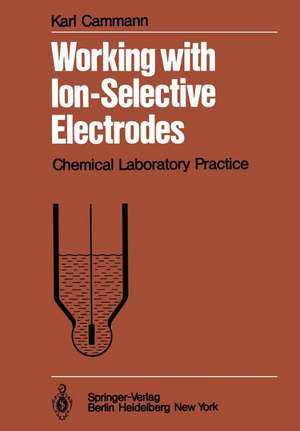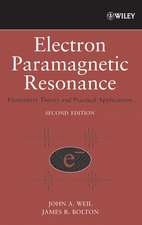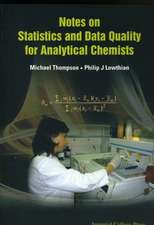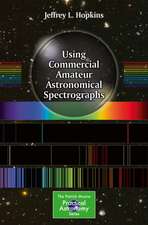Working with Ion-Selective Electrodes: Chemical Laboratory Practice: Chemical Laboratory Practice
Autor K. Cammann Traducere de A. H. Schröderen Limba Engleză Paperback – 15 noi 2011
Preț: 639.59 lei
Preț vechi: 752.45 lei
-15% Nou
Puncte Express: 959
Preț estimativ în valută:
122.42€ • 133.02$ • 102.90£
122.42€ • 133.02$ • 102.90£
Carte tipărită la comandă
Livrare economică 21 aprilie-05 mai
Preluare comenzi: 021 569.72.76
Specificații
ISBN-13: 9783642672781
ISBN-10: 3642672787
Pagini: 244
Ilustrații: X, 226 p.
Dimensiuni: 170 x 244 x 13 mm
Greutate: 0.4 kg
Ediția:Softcover reprint of the original 1st ed. 1979
Editura: Springer Berlin, Heidelberg
Colecția Springer
Seria Chemical Laboratory Practice
Locul publicării:Berlin, Heidelberg, Germany
ISBN-10: 3642672787
Pagini: 244
Ilustrații: X, 226 p.
Dimensiuni: 170 x 244 x 13 mm
Greutate: 0.4 kg
Ediția:Softcover reprint of the original 1st ed. 1979
Editura: Springer Berlin, Heidelberg
Colecția Springer
Seria Chemical Laboratory Practice
Locul publicării:Berlin, Heidelberg, Germany
Public țintă
ResearchCuprins
1 Fundamentals of Potentiometry.- 1.1 Electrode Processes.- 1.2 The Nernst Equation.- 1.3 Potential-Determining Ions.- 1.4 Ion-Selective Electrode Materials.- 1.5 The Potentiometric Selectivity Coefficient as a Quantitative Indication of the Electrode Selectivity.- 2 Electrode Potential Measurements.- 2.1 Reference Electrodes.- 2.2 The Standard Hydrogen Electrode as a Primary Reference Electrode.- 2.3 The Liquid Junction Potential.- 2.4 Secondary Reference Electrodes.- 3 Ion-Selective Electrodes.- 3.1 General Construction Principles.- 3.2 Solid-State Membrane Electrodes.- 3.3 Porous and Nonporous Supported Ion Exchanger and Neutral Carrier Membrane Electrodes.- 3.4 Solid State Electrodes with Electroactive Coatings.- 3.5 Gas Sensors For CO2, NH3, SO2, NO2, HF, H2S, HCN, etc..- 3.6 Bio-Sensors.- 4 Measuring Techniques with Ion-Selective Electrodes.- 4.1 Equivalent Circuit for a Cell with Liquid Junction.- 4.2 Measuring the EMF of an Electrochemical Cell.- 4.3 Choosing an EMF Measuring Device.- 4.4 Characteristics of Electrometer Amplifiers.- 5 Analysis Techniques Using Ion-Selective Electrodes.- 5.1 Calibration Curves.- 5.2 Direct Indication on the pH or plon Scale of an Instrument.- 5.3 Titration Procedures for Determining Concentrations.- 5.4 Concentration Determinations with the Help of a Standard Addition with a Known Electrode Slope S.- 5.5 Concentration Determinations with the Help of a Standard Addition with an Unknown Electrode Slope S.- 5.6 Practical Example of the Addition Method: Sodium and Potassium Determination in Blood Serum.- 5.7 Concentration Determinations with the Help of a “Mathematically Linearized” Titration Curve.- 5.8 Practical Example of the Gran Extrapolation Method: Determination of Chloride in the ppm Range.- 5.9. Determination of SomeCharacteristic Electrode Parameters.- 6 Applications of Ion-Selective Electrodes.- 6.1 Physiology, Biology, Medicine.- 6.2 Continuous Measurements in Industry and Environmental Research.- Outlook.- A.1 Concentration, Activity and Activity Coefficient.- A.1.1 Preparing Accurate Activity Calibration Solutions.- A.2 Survey of the Temperature Dependence of Commonly Used Reference Electrodes.- A.3 Table for Evaluation Using Analysis Technique 5.4.1.- A.4 Table for Evaluation Using Analysis Technique 5.4.2.- A.5 Table for Evaluation Using Analysis Technique 5.5.1.- A.6 Table for Evaluation Using Analysis Technique 5.5.2.- A.7 Evaluation Table for Standard Addition + 1:1 Dilution.- A.8 Ion-Selective Electrode Manufacturers and/or Dealers.- Literature.- Index of Symbols Used.













